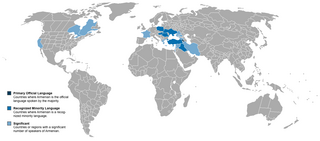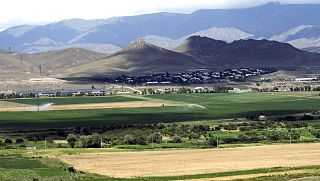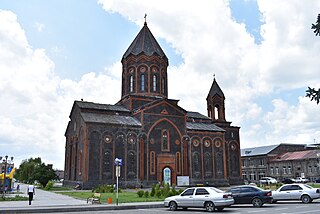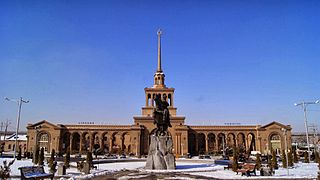| Ձիթողցյանների քաղաքային կենցաղի և ազգային ճարատարապետության տուն-թանգարան | |
Dzitoghtsyan Museum | |
| Established | 1984 |
|---|---|
| Location | Gyumri, |
| Type | Popular art, social life, architecture |
| Director | Sona Harutyunyan |
Officially Dzitoghtsyan House-Museum of Social Life and National Architecture (Armenian : Ձիթողցյանների քաղաքային կենցաղի և ազգային ճարատարապետության տուն-թանգարան), is a museum in Gyumri, Armenia. It was founded in 1984 in the Dzitoghtsyan family house, dating back to the 19th century. The museum exhibits elements of the daily urban life of Gyumri, as well as the local cultural and architectural characteristics of the city.

The Armenian language is an Indo-European language spoken primarily by Armenians. It is the official language of Armenia. Historically being spoken throughout the Armenian Highlands, today, Armenian is widely spoken throughout the Armenian diaspora. Armenian is written in its own writing system, the Armenian alphabet, introduced in 405 AD by Mesrop Mashtots.

Gyumri, is an urban municipal community and the second largest city in Armenia, serving as the administrative centre of Shirak Province in the northwestern part of the country. By the end of the 19th century, when the city was known as Alexandropol, it was one of the largest cities of Russian-ruled Eastern Armenia with a population similar to that of Yerevan. It was renamed to Leninakan during the Soviet period. The city's population grew above 200,000 prior to the 1988 Spitak earthquake, when it was devastated. As of the 2011 census, the city had a population of 121,976, down from 150,917 reported at the 2001 census.
The famous house of Dzitoghtsyan family was built in 1872 by 4 brothers who migrated from the Western Armenian village of Dzitogh, to the city of Alexandropol. [1] It is built with the famous red tuff stone of Shirak.

Tuff, also known as volcanic tuff, is a type of rock made of volcanic ash ejected from a vent during a volcanic eruption. Following ejection and deposition, the ash is compacted into a solid rock in a process called consolidation. Tuff is sometimes erroneously called "tufa", particularly when used as construction material, but properly speaking, tufa is a limestone precipitated from groundwater. Rock that contains greater than 50% tuff is considered tuffaceous.

Shirak, is a province (marz) of Armenia. It is located in the north-west of the country, bordering Turkey in the west and Georgia in the north. Its capital and largest city is Gyumri. It is as much semi-desert as it is mountain meadow or high alpine. In the south, the high steppes crash into mountain terrain, verdant green in the spring, hues of reddish brown in the summer. The province is served by the Shirak International Airport of Gyumri.
The house-museum, exhibits a collection of the Alexandropol social life characteristics, from the 19th century up to the 1920s. It also features the cultural, architectural and religious aspects of the city. [2]


















